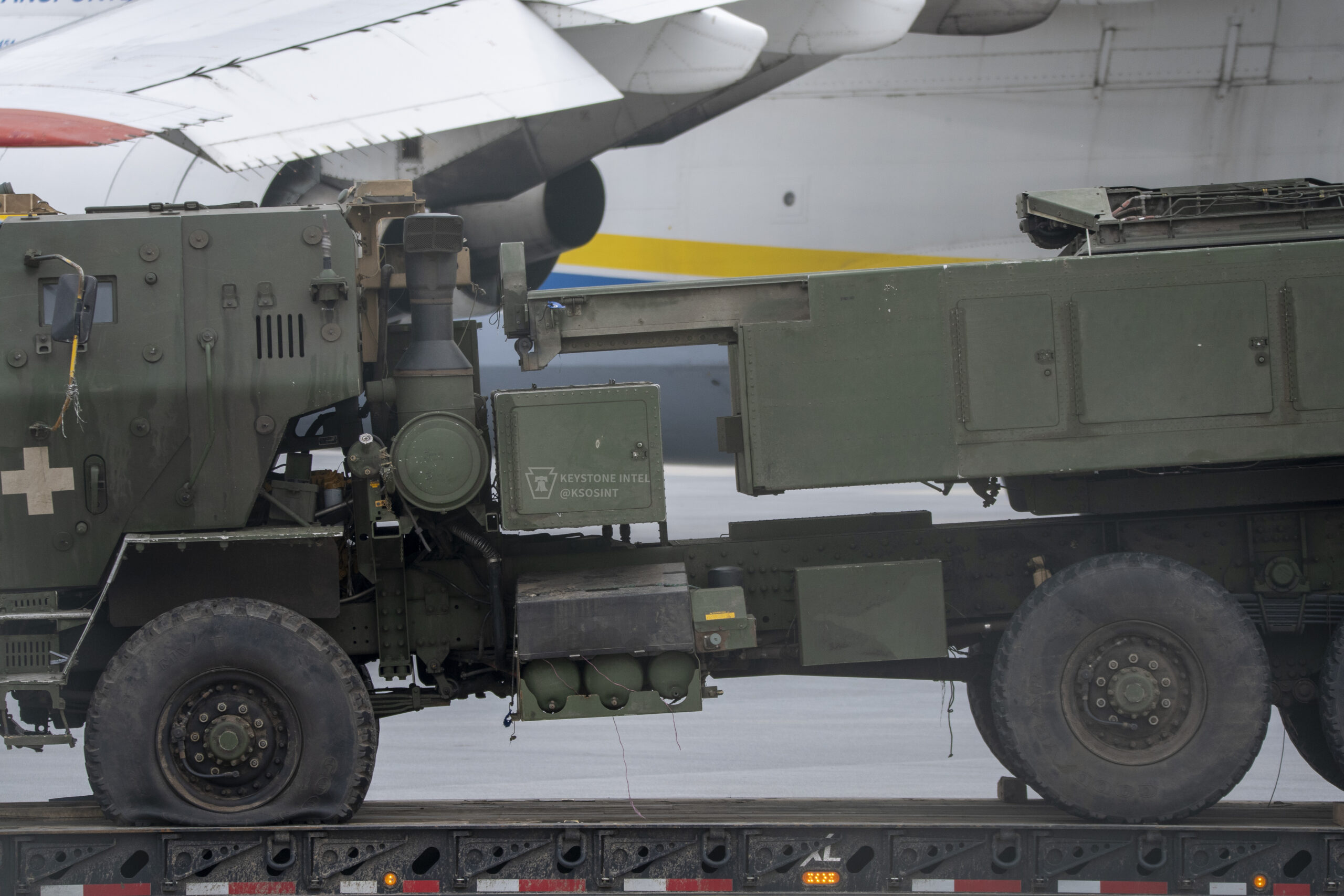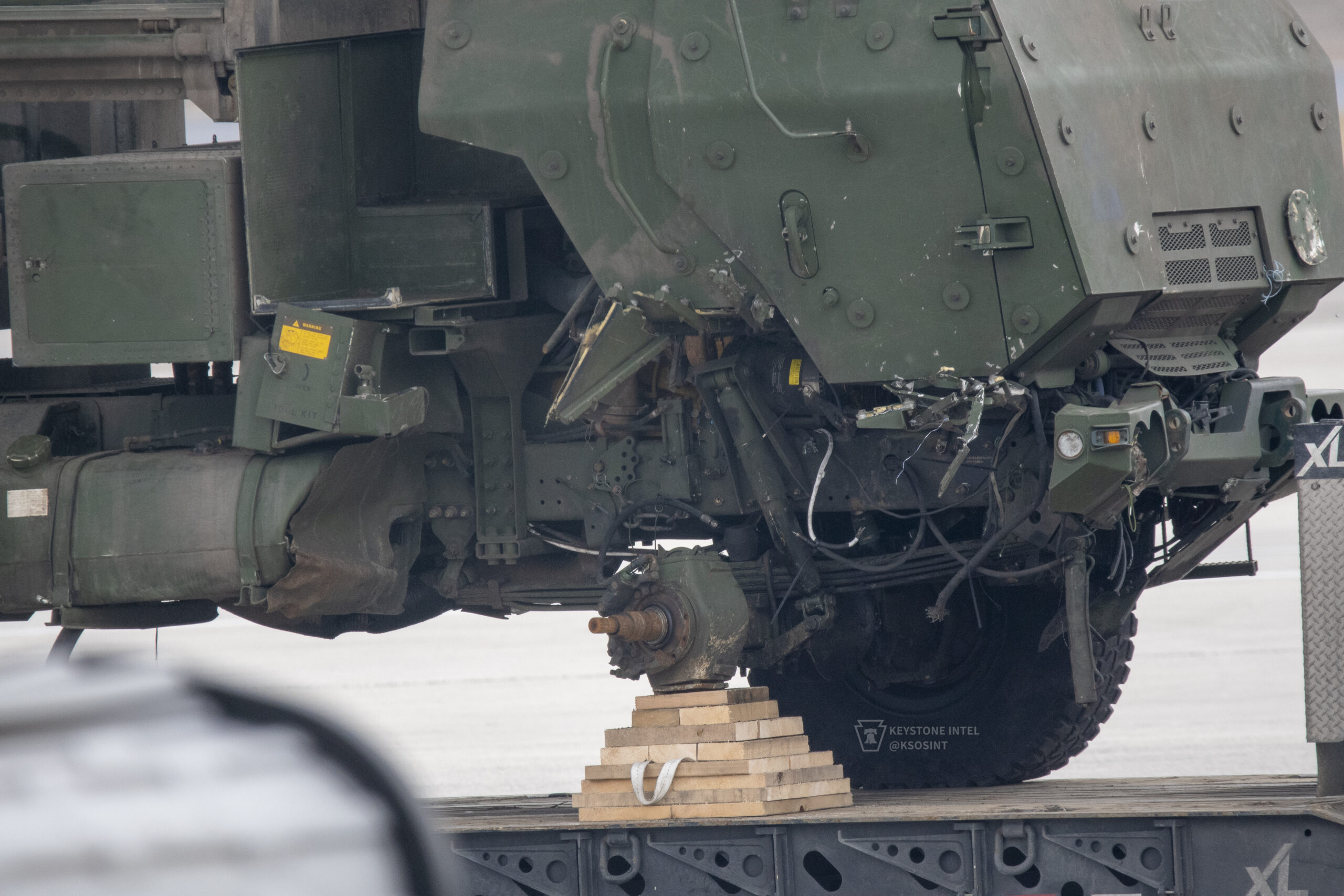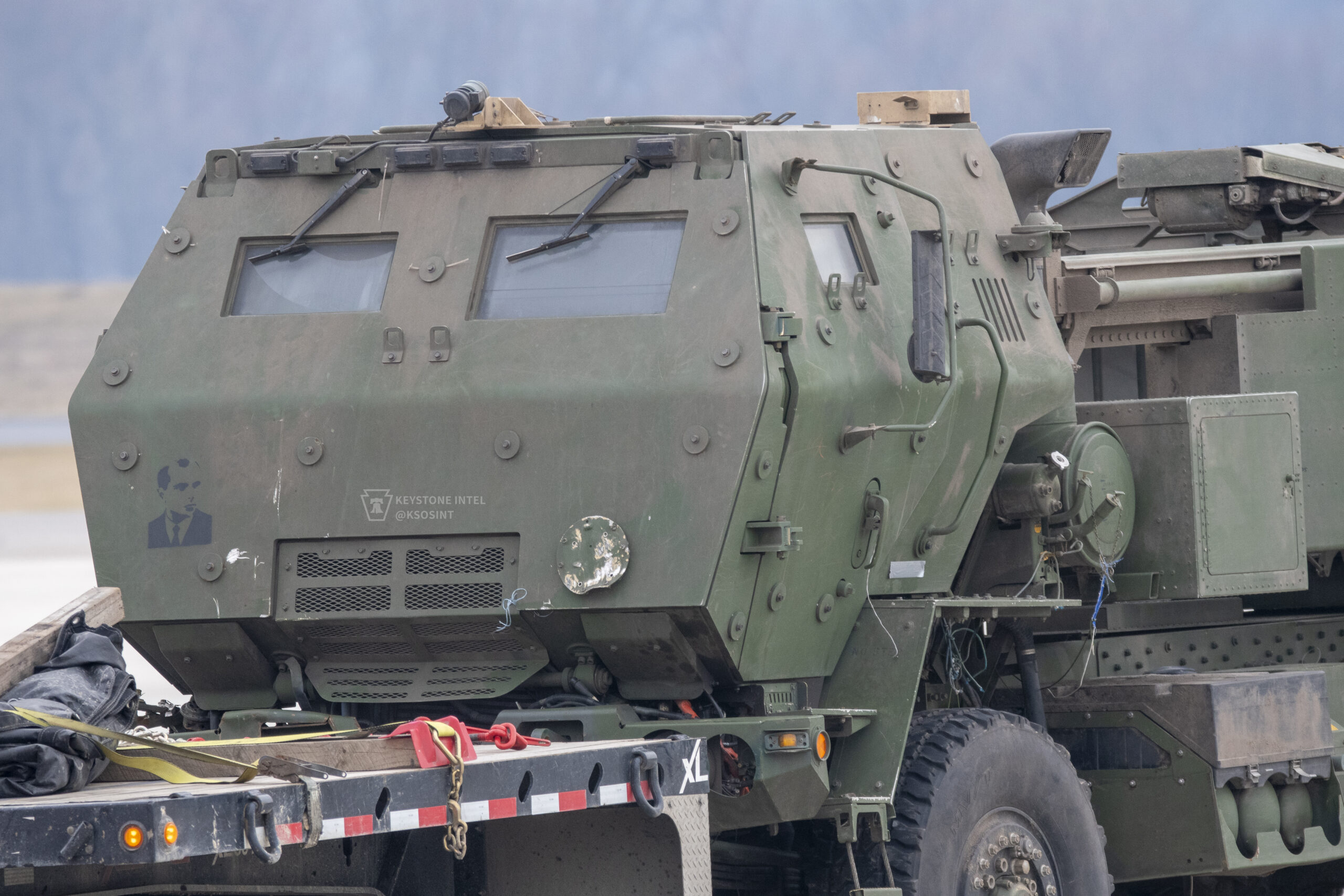A pair of Ukraine’s prized M142 High Mobility Artillery Rocket Systems (HIMARS) have returned to the United States, likely for repairs, after sustaining differing degrees of battle damage. Video and photos posted recently to social media show the HIMARS launchers, two of 39 delivered, being unloaded from an Antonov An-124 transport aircraft at Harrisburg International Airport in Middletown, Pennsylvania.

A series of photos of the HIMARS as they were being unloaded was also shared with The War Zone by Keystone Intel (@KSOINT) and you can see them below, as well as the top of this story.
As we have discussed before, the M142 HIMARS uses a 6×6 Family of Medium Tactical Vehicles (FMTV) truck chassis to mount a single pod of rockets (the M270 Multiple Launch Rocket System, which is mounted on a tracked chassis, can carry two). These include M31 guided types that can hit with great precision over 50 miles and have been a major advantage for Ukrainian forces.
Of the two M142 vehicles, the first — distinguished by its prominent white-cross identification markings — appears to have sustained shrapnel damage on at least one side, with as many as 16 hits visible, although, overall, the damage seems fairly minor. Both armored front windows have also been damaged.



The second vehicle looks like it may have struck a mine and has more significant damage, including the loss of the front wheel on the right-hand side and parts of the bottom of the cab having been torn off. Notable on the second vehicle is also the portrait of Ukrainian far-right militant leader Stepan Bandera on the front of the cab.



As far as is known, no Ukrainian HIMARS has been confirmed damaged (or destroyed) until now. Despite many Russian claims to the contrary, none of these has so far been supported by convincing imagery.
Before diving into more developments from the conflict in Ukraine, The War Zone readers can review our previous coverage here.
The Latest
The most recent wave of Russian missile and drone strikes against Ukraine overnight saw 14 out of 17 one-way attack drones brought down by Ukrainian air defenses, according to the Ukrainian Air Force. The service also said that it successfully destroyed a single Kh-59 series air-launched standoff missile.
The latest attacks continue Russia’s winter campaign that’s been directed against Ukrainian energy, military, and transport infrastructure, among other targets.
On the Telegram messaging app, the Ukrainian Air Force said that the Russian attacks involved examples of the S-300 long-range surface-to-air missile system used in a land-attack capacity. No details were provided about how many of these missiles were used, or whether any were intercepted.
Oleh Synehubov, the governor of the Kharkiv region in the northeast of Ukraine, said late on Sunday that Russia launched missiles from S-300 systems located in Russia’s Belgorod region that borders Ukraine. Synehubov said that, according to preliminary information, there were no casualties, but some non-residential buildings were damaged.
In the Dnipropetrovsk region, local governor Serhiy Lisak said that the city of Pavlohrad came under attack from Russian drones. There were no casualties, but some parts of the city were left without power outages, he added. These reports have not been independently verified.
At least one of the Shahed-series one-way attack drones brought down in the Dnipropetrovsk region was reportedly defeated by an undisclosed electronic warfare system. This non-kinetic approach to dealing with the Shahed menace resulted in this particular drone being recovered with apparently only minimal damage.
This incident comes amid reports of a new electronic warfare system known as Pokrova that reportedly operates by sending fake signals to the drones’ navigation equipment, using spoofing rather than jamming. This would pull them off course and make hitting their intended targets more challenging if not impossible. Uncomfirmed reports suggest that Pokrova is already being put to effective use against drones “throughout the entire country.”
Meanwhile, other reports coming out of Ukraine suggest that Russia may have developed countermeasures of its own to defeat at least some of the electronic warfare systems that are being used to jam or disrupt its drones.
Ukrainian electronic warfare specialist Serhiy Flash recently claimed that Russia is now using artificial intelligence to overcome existing anti-drone jamming technologies. We did a very in-depth report on exactly this that you can read here.
At the smaller end of the scale, Ukranians are also looking at new ways of defeating first-person-view (FPV) drones, which have proven to be a particular menace on the battlefield. Ukrainian officials have also warned repeatedly that the Russian inventory of such weapons now greatly exceeeds the numbers available to their own forces. The anti-FPV gun below works by firing a net toward the drone, which is then snagged and broight to the ground. Although it apparently only would be effective at very close range, it can be imagined that it could have an application in trench warfare, for example and we have seen FPV drones stalk individuals at close range multiple times before.
On the Russian side, this tank displays a ad-hoc anti-FPV measure of its own, with empty shell cases attached along the side of the hull, in turn with branches protruding vertically from out of them. The effectiveness of the arrangement seems to be highly dubious, although it does at least reflect the desperate measures that are now being taken to try and deal with explosives-laden FPV drones.
A better known anti-drone measure in Ukrainian service is the ‘technical’ vehicle, used to form mobile fire teams, with vehicles normally armed with heavy machine guns of diffrent kinds. In this case, the all-American anti-drone technical comprises an HMMWV, or Humvee mountng a pair of 50-caliber M2 Browning machine guns.
Something of the scale of the problem that Ukraine faces in terms of smaller Russia drones, or in this case, loitering munitions, can be seen in the video below, showing stacks of Zala Aero’s KYB-UAV and Lancet drones, awaiting delivery to the troops.
The following video shows another interesting drone scenario, with the retrieval of a damaged or abandoned Russian Orlan-30 surveillance drone using a Ukrainian uncrewed ground vehicle. The Orlan was recovered after purportedly coming down in the no man’s land between Russian and Ukrainian lines.
Russia has growing drone problems of its own, with Ukraine increasingly calling upon new types of long-range one-way attack drones to hit back at infrastructure targets often deep behind the Russian border. In the video below, a Mi-24 Hind attack helicopter can be seen giving chase to a Ukrainian drone somewhere in the Leningrad region, which has come under high-profile attack by drones in recent weeks. Previous reports have emerged of Russian attack helicopters being held back for defensive missions to counter Ukrainian drones in Russian airspace, meaning fewer of these important assets are available on the battlefield in Ukraine.
The threat posed to Russia by Ukrainian long-range drones shows no signs of abating, with the latest official claims from Kyiv suggesting that there are now “up to 10” engaged in building attack drones that can reach Moscow and St. Petersburg. That claim comes from Mykhailo Fedorov, Ukraine’s digital minister, who also claimed that Ukraine will produce “thousands” of long-range drones in 2024.
Among the existing long-range attack drones in Ukrainian hands is the Morok, which has been in use for some time but is only rarely seen. The Morok was originally designed as an aerial target, known as the RZ-60. It reportedly has a range of 186 miles and a fairly light warhead of only around six pounds. After being launched by a rocket, it can fly at a speed of up to 180 miles per hour.
Fighting continues on the waterways of Ukraine, as evidenced by this undated video, showing the evacuation of a Ukrainian casualty by boat, while under intense fire from the Russian side. The unit apparently seen here is the 38th Separate Marine Brigade, part of the Ukrainian Marine Corps that has been heavily involved since the launch of the counteroffensive last summer.
Ukraine has claimed that Russian forces are using terminals of Elon Musk’s satellite internet service Starlink in occupied areas of the country. The Ukrainian military released what it said was an intercept of an exchange between two Russian soldiers as proof of the “systemic” use of the Starlink system by Russia. Ukraine, for its part, has relied heavily on Starlink for battlefield communications since the full-scale Russian invasion began.
“Cases of the Russian occupiers’ use of the given devices have been registered. It is beginning to take on a systemic nature,” said Andriy Yusov, a spokesperson for the Defence Intelligence of Ukraine (GUR).
The GUR said terminals were being used by units including Russia’s 83rd Air Assault Brigade, which is fighting near Klishchiivka and Andriivka in the partially occupied eastern region of Donetsk.
Starlink has denied that it sold any terminals to Russia, that it has no evidence of third parties having done so, and that its network does not operate in Russia. At the same time, statements by Starlink and Musk stopped short of denying outright claims that Russian troops may have obtained the devices and be using them regardless, including in parts of Ukraine that it occupies.
Moscow has also denied that it’s using Starlink, Kremlin spokesman Dmitry Peskov telling reporters:
“This is not a certified system with us; accordingly, it cannot be officially supplied here and is not officially supplied. Accordingly, it cannot be used officially in any way.”
We have seen Ukrainian-operated M2 Bradley infantry fighting vehicles in some dramatic scenes of combat in recent months. The following videos show the state of a pair of Bradleys after they had been engaged with Russian forces, with multiple instances of shrapnel damage around the sides of the hull.
We have reported in the past how the British-supplied AIM-132 ASRAAM (Advanced Short-Range Air-to-Air Missile) has been adapted for surface launch, providing Ukraine with a new mobile ground-based air defense system.
The following video is well worth a watch, to learn more about this intriguing system, developed and fielded very rapidly, and using a 6×6 Supacat all-terrain truck chassis, with a twin-rail launcher for a pair of ASRAAMs mounted at the rear.
A Russian surface-to-air missile sytem next, and an example of the latest S-350 Vityaz, which has appeared for the first time within Ukrainian borders. Its first appearance in the war in Ukraine involved deployment at an airbase less than 40 miles from the Ukrainian border, as you can read about here.
What is interesting about this footage is that it shows one of the new medium-range surface-to-air missile systems falling victim to an — apparently Russian minefield — in what is purportedly the Luhansk region in eastern Ukraine.
The U.S. Air National Guard says that the first four Ukrainian pilots training to fly the F-16 are “on track,” according to a report from Air & Space Forces. The first batch of pilots are being trained at Morris Air National Guard Base, Arizona. However, Gen. Daniel R. Hokanson has warned that Congress needs to authorize more if additional Ukrainian pilots are to join the training pipeline.
A multinational training effort for Ukrainian F-16 pilots is taking place in the United States and in Europe.
“We are aiming to provide an initial operating capability for Ukraine with its F-16 program in 2024, which would entail trained pilots, the platforms, but in addition, trained maintainers and sustainers, infrastructure, and spare parts, ammunition,” Celeste Wallander, assistant secretary of defense for international security affairs, told reporters last month.
There are signs that the long-delayed next package of U.S. air for Ukraine may finally be inching forward, but big hurdles remain.
During a rare Sunday session, the U.S. Senate voted 67-27 to move the bill to the next phase, edging it toward a final vote to pass it.
Worth around $95 billion, the package includes aid for Ukraine, Israel, and Taiwan. While the bill is bipartisan and therefore has support from Democrats and some Republicans in the Senate, it is opposed by some Republican hardliners and former President Donald Trump.
Should it gain Senate approval, the bill would still need to be looked at by the House of Representatives, where it will likely again face Republican obstruction.
The German Chancellor Olaf Scholz today announced that his government would support defense companies through an increase in military spending. During a visit to the future site of a Rheinmetall arms factory in central Germany, Scholz said that Berlin would also meet its NATO commitment to spend two percent of GDP on defense.
The reference to the two percent GDP spending target was in response to comments from former U.S. President Donald Trump, who recently warned that the United States might not protect fellow NATO members who are not spending enough on defense against a potential Russian invasion.
This follows a warning on Friday from the Danish Minister of Defense Troels Lund Poulsen, who said that Russia may attack a NATO country within three to five years.
In another reference to the potential for the United States to dramatically downscale its commitment to Ukraine, especially if Trump should be re-elected, Scholz called upon Germany and Europe’s defense industry to increase its production of arms, especially ammunition.
The problem of scaling up European ammunition production to meet demands was also addressed recently by Belgium’s former deputy chief of defense.
“It’s not a joke, we’re in deep shit,” Marc Thys, who retired in 2023 with the rank of lieutenant general, told POLITICO. “Especially in Belgium, but we’re not the only ones.”
Ukrainian hopes of unwanted Australian Army MRH90 Taipan helicopters being handed over as defense aid appear to have been struck a blow.
According to a report from the Ukrainian Militarnyi defense website, the Australian Ministry of Defense has blocked any potential transfer of Taipan helicopters to Ukraine.
The Australian Ministry of Defense reportedly consider that the MRH90s are not suitable for Ukraine, which had looked into obtaining them for combat search and rescue duties.
While the Australian Army has been deliberately wrecking and literally burying the helicopters, as you can read about here, several reportedly remain airworthy although they are also earmarked for disposal.
That’s it for now.
Contact the author: thomas@thewarzone.com
